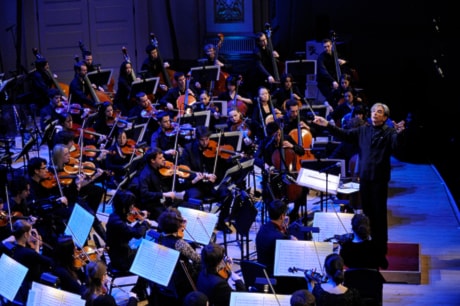NEW YORK — Even before they played their first note together, they were listed as one of the world’s most inspiring orchestras.
Part publicity stunt by its producers, part vanity trip by its participants, part opportunity to attract a younger crowd to classical music, the YouTube Symphony Orchestra made its much anticipated debut Wednesday night at Carnegie Hall.
In the four months since the project was announced, more than 3,000 videos submitted by amateur and professional musicians from 70-plus countries were auditioned.
Voters among the 15 million viewers of http://www.YouTube.com/Symphony selected the 93 winners from 30 countries, who ranged from ages 15 to 55 and included a surgeon-violinist and a professional poker player-cellist.
Five Canadians were picked: vibraphone player Gael Chabot-Leclerc from Saguenay, Que., viola player Yunior Lopez from Toronto, violinist Donovan Seidle from Calgary, cellist Stephane Tetreault from Montreal and bass player Ian Whitman from Kitchener, Ont.
“We’re meeting a lot of different worlds,” conductor Michael Tilson Thomas told the audience before the first downbeat, “the real time world, the online world and the experience of getting acquainted. For us it’s been something between a classical music summit conference (and) scout jamboree combined with speed dating.”
Only last month, the prestigious British magazine Gramophone placed the group among the 10 most inspiring orchestras, praising it “for democratising classical music on a global scale, making it truly all-inclusive.”
“It’s turned classical music into something everybody’s talking about, huge numbers are engaging, thinking about and also understanding it could be something for them,” Carnegie Hall Executive Director Clive Gillinson said in an interview.
But could the group play together in a live performance, with only a few days of rehearsals, and at one of the world’s leading classical music venues?
“Playing at Carnegie Hall is such a thrill to me,” 36-year-old flutist Nina Perlove of Cincinnati said in an interview.
“I actually didn’t think I’d be so moved because I’m a professional musician and I’ve played in nice concert halls before. But when we walked out on stage for the first time and I looked out, I got kind of watery. I was thinking about my grandfather who loved New York and was a musician and how he would be so moved.”
From the joyous third movement of Brahms’ Fourth Symphony, which opened the concert to the fiery crashes of Tchaikovsky’s Fourth Symphony at the end, Thomas led the musicians in a remarkable performance.
In between these immortal pillars, the orchestra played a wide assortment of works, including challenging pieces by Lou Harrison, Heitor Villa-Lobos, John Cage and the world premiere of Tan Dun’s Internet Symphony No. 1, Eroica.
Despite the short preparation time, they played like a finely tuned instrument. For example, the string players’ bows moved in synch and flew through the air at rousing conclusions.
The musicians arrived in New York Sunday. During rehearsals, they were coached by leading orchestral musicians, including Roberto Diaz, president of the Curtis Institute of Music and former principal violist with the Philadelphia Orchestra.
“It was a very talented group of individuals,” Diaz said in an interview. “Every rehearsal, it’s just gotten better and better, and they’ve gotten this sense of group rhythm, which is a fundamental part of it all. . . . To do that in 48 hours is amazing.”
